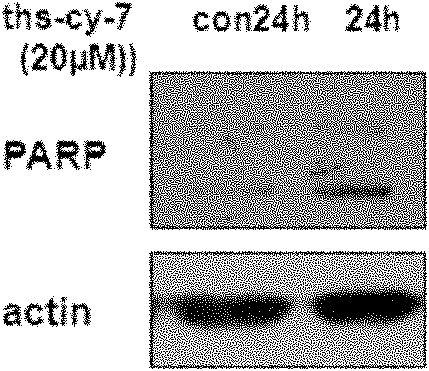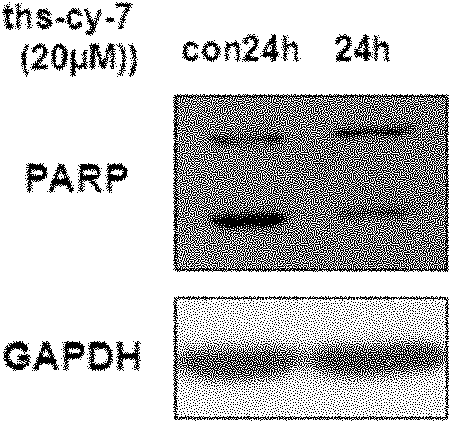Anticancer application of sesquiterpene
A sesquiterpene, cancer technology, applied in the field of anti-cancer application of sesquiterpene ths-cy-7, can solve the problems of unreported biological effects
- Summary
- Abstract
- Description
- Claims
- Application Information
AI Technical Summary
Problems solved by technology
Method used
Image
Examples
Embodiment 1
[0031] Example 1 Sesquiterpene ths-cy-7 induces tumor cell apoptosis
[0032] 1) Sesquiterpene ths-cy-7 induces PARP protein degradation in cells
[0033] Liver cancer cells HepG2 were selected, cultured in 6-well tissue culture plates at 37°C and 5% carbon dioxide incubator, and treated with 20 μmol / L ths-cy-7 serum-free DMEM for 3, 6, 12, and 24 hours after 24 hours.
[0034] Liver cancer cells 7703 and cervical cancer cells Hela were selected, cultured in 6-well tissue culture plates at 37°C and 5% carbon dioxide incubator, and treated with 20 μmol / L ths-cy-7 serum-free DMEM for 24 hours after 24 hours.
[0035] Cells were lysed on ice for 30 min with modified RIPA lysis buffer (50 mM Tris-Hcl, pH 7.4; 150 mM NaCl; 5 mM EDTA; 1% NP-40, 0.5% sodium deoxycholate, 0.1% SDS). With the same loading amount, 8% SDS-PAGE electrophoresis, transfer membrane, block with 5% skimmed milk powder TBST (50mM Tris-HCl (pH 7.4), 150mM NaCl and 0.1% Tween-20) at room temperature for 1h, at r...
Embodiment 2
[0039] Effect of embodiment 2ths-cy-7 on Nur77 transcript level expression
[0040] 1) Cell culture
[0041] Select the human lung cancer cell line NIH-H460, in 10% calf serum DMEM medium (purchased from Hyclone), 37 ° C containing 5% CO 2 The cells were cultured in a 6-well tissue culture plate in a 6-well tissue culture box, and after 24 hours, the serum-free medium was changed to starve for 12 hours, and then the drug (serum-free) was added for treatment. ths-cy-7 was dissolved in DMSO (DMSO final concentration <0.2%), treated with 1 and 10 μmol / L respectively for 3 h, the negative control group was treated with the same concentration of DMSO for 3 h, and the positive control group was treated with phorbol ester 100 ng / mL ( TPA) processing 3h, concrete processing is as follows:
[0042] (1) negative control group (DMSO);
[0043] (2) positive control group (TPA);
[0044] (3) ths-cy-7 group (1 μmol / L);
[0045] (4) ths-cy-7 group (10 μmol / L).
[0046] Cells are collec...
Embodiment 3
[0049] Example 3 Induction of ths-cy-7 to Nur77 protein level expression
[0050] 1) Cell culture
[0051] In order to confirm the dose-effect relationship between ths-cy-7 and Nur77 expression, liver cancer cell HepG2 and lung cancer cell A549 were selected, and DMEM medium containing 10% fetal bovine serum (purchased from Hyclone) was used at 37°C with 5% CO 2 The cell culture box was cultured in a 6-well tissue culture plate. After 24 hours, the cells were treated with ths-cy-7. The treatment concentrations were 1, 5, 10, and 20 μmol / L, respectively, and the treatment time was 3 hours. The cells without any treatment were used as control.
[0052] In order to confirm the temporal relationship between ths-cy-7 and Nur77 expression, four cancer cells were selected: liver cancer cell HepG2, cervical cancer cell Hela, colon cancer cell HCT-116, and lung cancer cell A549, and the specific treatments were as follows:
[0053] (1) HepG2 cells were treated with ths-cy-7 at a conc...
PUM
 Login to View More
Login to View More Abstract
Description
Claims
Application Information
 Login to View More
Login to View More - R&D
- Intellectual Property
- Life Sciences
- Materials
- Tech Scout
- Unparalleled Data Quality
- Higher Quality Content
- 60% Fewer Hallucinations
Browse by: Latest US Patents, China's latest patents, Technical Efficacy Thesaurus, Application Domain, Technology Topic, Popular Technical Reports.
© 2025 PatSnap. All rights reserved.Legal|Privacy policy|Modern Slavery Act Transparency Statement|Sitemap|About US| Contact US: help@patsnap.com



